Timeline of steel
This is a timeline of steel, attempting to describe historic events related to the discovery, science and industrial development of the alloy.
Big picture
| Time period | Development summary |
|---|---|
| < 100 AD | Steel has been produced on a small scale for thousands of years. Roman, Iberian and Chinese civilizations make early use of steel to construct weapons. However, these ancient civilisations had yet to master methods of producing steel and so its uses are limited and subject to very long production times.[1] |
| 17th century | Iron's properties become well understood, but increasing urbanization in Europe demands a more versatile structural metal.[2] Blister steel, one of the earliest forms of steel, begin production in Germany and England and is produced by increasing the carbon content in molten pig iron using a process known as cementation.[2] |
| 18th century | The Industrial Revolution leads to an increased demand for wrought iron, which is the only material available in sufficient quantity that could be used for carrying loads in tension. About the beginning of the century, coke produced from coal begins to replace charcoal as the fuel for the blast furnace; as a result, cast iron becomes cheaper and even more widely used as an engineering material.[3] By the late century, ironmakers learn how to transform cast pig iron into a low-carbon content wrought iron using puddling furnaces.[2] |
| 19th century | The growth of railroads in both Europe and America puts great pressure on the iron industry, which still struggles with inefficient production processes.[2] The amount of iron being consumed by expanding railroads provides metallurgists with the financial incentive to find a solution to iron's brittleness and inefficient production processes. The history of the steel industry in the modern times is initiated during the 1850s, with the development by Henry Bessemer of an effective way to use oxygen to reduce the carbon content in iron.[4] In the late century, capitalists invest and make fortunes in the steel industry.[2] Britain produces about 30 million tons of steel each year by the end of the century.[5] |
| 20th century | Blister steel continues to be made on a small scale.[3] Since the 1950s in particular, flat-rolled stainless steel materials are used wherever high dependability, functionality and hygiene are required.[6] The cost efficiencies of oxygen steelmaking makes open-hearth factories uncompetitive and, following the advent of oxygen steelmaking in the 1960s, open-hearth operations begin closing.[2] After the 1980s, China grows strongly enough and becomes the largest producer of steel.[4] |
| 21th century | Today, the majority of global steel production —about 66%, is produced in basic oxygen facilities.[2] China is by far the largest producer of steel. |
Full timeline
| Year | Event type | Details | Present day country/region |
|---|---|---|---|
| 4000 BC | First evidence of use of iron.[7] | ||
| 2000 BC | Production | Iron production begins in Anatolia. The earliest known steel is about 4,000 years old and was excavated in Turkey.[1] | Turkey |
| 10th century BC | Consumption | Iron working is introduced to Greece in the late 10th century BC.[8] | Greece |
| 6th century BC | Facility | Blast furnaces are developed in China.[2] | China |
| 6th century BC | Technology | Wootz steel is developed in India. Craftsmen in the southern part of the country use crucibles to smelt wrought iron with charcoal to produce ‘wootz’ steel.[9][10][11] | India |
| 500 BC | Technology | The technology of iron making reaches the western limits of Europe.[3] | Europe |
| 400 BC | Technology | The technology of iron making reaches China.[3] | China |
| 300 BC | Technology | Wootz steel making technique develops in India and Sri Lanka. The technique spreads across the Arabian peninsula.[7] | India, Sri Lanka |
| 300 BC – 1700 AD | Technology | Era of the legendary Damascus Steel.[1] | Near East |
| 206 BC – 25 AD | Technology | The Chinese during the Han dynasty can already produce heat-treated steel.[3] | China |
| 2nd century BC | Production | Early examples of high-quality steel are produced in China.[12] | China |
| 402 AD | Product | The Iron Pillar of Delhi is erected at around that time. It is the oldest surviving example of rust-resistant steel.[12] | India |
| 1100 – 1300 | Technology | Wootz steel comes to the attention of Europeans in the form of Damascus swords, which are extremely strong, shatter-ressistant and can be sharpened to a fine blade.[7] | |
| 12th century | Production | By the 12th century, Sri Lanka is the world’s largest supplier of crucible steel.[12] | Sri Lanka |
| 1336 – 1573 | Product | During the Muromachi period, Japan exports a large number of swords to Ming dynasty China.[13] | Japan, China |
| 1400 | Product | Cutlery made of steel begins to appear in Britain.[7] | United Kingdom |
| 1702 | Coke is first used to smelt iron ore on a mass scale, replacing wood and charcoal which start becoming increasingly scarce.[12] | ||
| 1712 | Product | English inventor Thomas Newcomen builds the first commercially successful steam engine.[12] | United Kingdom |
| 1751 | Production | Crucible steel is produced. English manufacturer Benjamin Huntsman develops techniques for production of high quality steel, when he establishes a steelworks at Sheffield, England, where the steel is made by melting blister steel in clay crucibles at a temperature of 1,500° to 1,600° C (2,700° to 2,900° F), using coke as a fuel.[3][7] | United Kingdom |
| 1783 | Product | English ironmaster Henry Cort invents the steel roller for steel production.[12] | United Kingdom |
| 1784 | Technology | English ironmaster Henry Cort develops puddling furnaces, which would be used by ironmakers to transform cast pig iron into a low-carbon content wrought iron.[14][15][2] | United Kingdom |
| 1794 | Technology | Welsh inventor and ironmaster Phillip Vaughan patents the design for the ballbearing to support the axle of a carriage.[12] | United Kingdom |
| 1810 | Organization | German steel manufacturer Friedrich Krupp establishes the Krupp AG company.[16][17][18] | Germany |
| 1821 | Scientific development | French engineer Pierre Berthier publishes the results of his studies into chromium alloys and ferro-chromium.[7] | France |
| 1856 | Technology | English inventor Henry Bessemer develops an effective way to use oxygen to reduce the carbon content in iron. The Bessemer converter (so called because it converts iron into steel) blows air through molten pig iron, which removes its carbon, making it more malleable. The interaction of oxygen and carbon generates a heat which increases the temperature of molten iron, allowing steelmakers to avoid using additional fuel. The process developed by Bessemer becomes a major breakthrough, giving birth to the modern steel industry.[2][19][20] | United Kingdom |
| 1860 | Production | There are 3,400 puddling furnaces in Britain producing a total of 1.6 million tons of wrought iron per year, about half the world’s production.[3] | United Kingdom |
| 1860 | Production | Crucible steel starts being produced in Pittsburgh, Pennsylvania, using a charge of wrought iron and pig iron.[3] | United States |
| 1860s | Technology | German engineer Karl Wilhelm Siemens further enhances steel production through his creation of the open hearth process, which produces steel from pig iron in large shallow furnaces.[2] | |
| 1860s | Following the American Civil War, the United States' steel production grows with astonishing speed, led by Scottish-American industrialist, Andrew Carnegie.[12] | United States | |
| 1867 | Production | The world production of steel is estimated at 22,000 tons during the year.[21] | |
| 1867 – 1884 | Prices for steel rail drop more than 80% in that period, as a result of the new steel producing techniques, initiating growth of the world steel industry.[2] | ||
| 1868 | Technology | British metallurgist Robert Forester Mushet invents tungsten steel.[12] | |
| 1872 | Technology | Englishmen John T. Woods and John Clark file for patent of an acid and weather resistant iron alloy containing 30-35% chromium and 2% tungsten, effectively the first ever patent on what would now be considered a stainless steel.[22][7][23] | United Kingdom |
| 1875 | Scientific development | Henri Aimé Brustlein from France details the importance of low carbon content in successfully making stainless steel. Brustlein points out that in order to create an alloy with a high percentage of chromium, the carbon content must remain below around 0.15%.[22] | France |
| 1876 | Technology | English inventor Sidney Gilchrist Thomas develops a solution to the phosphorus content (a deleterious impurity that makes steel brittle) by adding a chemically basic flux—limestone—to the Bessemer process. The limestone would draw phosphorus from the pig iron into the slag, allowing the unwanted element to be removed.[2][24][25][13] | United Kingdom |
| 1883 | Product | The Brooklyn Bridge –the first steel suspension bridge, is innaugurated in New York City.[12][26][27] | United States |
| 1885 | Product | The Home Insurance Building –the first steel skyscraper, is completed in Chicago.[12] | United States |
| 1888 | Technology | The Open Hearth process of steel production (which makes the industries to produce steel out of domestic iron ores) is first adopted by the steel industries in United States.[4] | United States |
| 1891 | Organization | German steel producer Thyssen is founded.[28][29][30] | Germany |
| 1895 | Facility | A small crucible steel works is started in Tokyo.[3] | Japan |
| 1895 | Technology | German chemist Hans Goldschmidt develops the aluminothermic reduction process for producing carbon-free chromium, thus prompting a major boost in the development of stainless steels.[22] | |
| c.1900 | Production | Japanese state-run Yawata Iron & Steel Co., Ltd., outfitted with German engineering, begins the production of steel on a large scale, with Japan starting to import more iron, ore, and coke to feed the growth.[13] | Japan |
| 1901 | Organization | Carnegie's US Steel Corporation is founded. It would be the first corporation ever launched valued at over one billion dollars.[2] | United States |
| 1901 | Organization | Sumitomo Steel Works is established in Osaka, Japan.[31] | Japan |
| 1901 | Organization | Brazilian steelmaker Gerdau is established.[32][33] | Brazil |
| 1901 | Organization | Thw United States Steel Corporation is founded.[34][35][36] | United States |
| 1904 | Scientific development | French metallurgist Léon Guillet undertakes extensive research on many iron-chromium alloys.[22] | |
| 1907 | Technology | The first commercial electric arc furnace (EAF) is established in the United States. Today, almost all stainless steel is produced using the EAF method.[7] | United States |
| 1907 | Organization | Tata Steel is established in India.[37][38][39] | India |
| 1908 | Scientific development | Frederik Becket of the Electro Metallurgical Company at Niagara Falls, New York develops a low-carbon ferrochromium produced by reducing the chromium oxide with silicon instead of aluminum.[40] Over 80% of the world's ferro chrome today is utilized in the production of stainless steel.[41] | United States |
| 1909 | Scientific development | Metallurgist W. Giesen publishes an in-depth work regarding chromium-nickel steels.[22] | |
| 1909 | Scientific development | French engineer Albert Marcel Portevin and W. Giesen publish information on stainless steels that are roughly equivalent to modern austenitic, martensitic, and ferritic stainless steels.[7] | |
| 1909 – 1912 | Scientific development | Eduard Maurer and Benno Strauss at Krupp laboratories develop high-chromium nickel steels.[40] | Germany |
| 1911 | Germans P. Monnartz and W. Borchers discover the correlation between chromium content and corrosion resistance, stating that there is a significant boost in corrosion resistance when at least 10.5% chromium was present. The pair also publishes detailed works on the effects of molybdenum on corrosion resistance.[22][42] | ||
| 1911 | Scientific development | American metallurgist Elwood Haynes experiments with high-chromium steels to determine the effect of chromium on corrosion resistance, hardness, elasticity, and cutting qualities. In the same year, Christian Dantsizen of General Electric Research Laboratory also begins experimenting with high-chromium steels for possible commercial development.[40] | United States |
| 1912 | Scientific development | English metallurgist Harry Brearley, working in the Brown-Firth research laboratory in Sheffield, England, discovers a martensitic stainless steel while attempting to develop an erosion-resistant alloy for military applications.[43] In 1913 Brearley melts the first commercial chromium steel as a stainless steel for cutlery blades.[40] Harry Brearley is credited with the invention of stainless steel.[12] | United Kingdom |
| 1912 | Scientific development | Max Mauermann of Poland creates an early stainless steel.[22] | |
| 1913 | Scientific development | English researcher Harry Brearley creates a steel with 12.8% chromium and 0.24% carbon, argued to be the first ever stainless steel.[22] | United Kingdom |
| 1914 | Scientific development | Ludlum Steel Co. metallurgist P.A.E. Armstrong discovers chromium-silicon steels, when a small electric furnace is accidentally contaminated due to some silicon reduced from the asbestos cover on the electrode.[40] | United States |
| 1917 | Scientific development | Charles Morris Johnson of the Crucible Steel Company, begins investigating chromium-nickel-silicon steels, which are later patented under the name Rezistal.[40] | United States |
| 1919 | Technoology | American metallurgist Elwood Haynes obtains a patent on martensitic stainless steel.[7] | United States |
| 1919 | Organization | Chinese steelmaker Shougang Corporation is founded.[44][45] | China |
| 1919 – 1923 | Product | Cutlers in Sheffield, England start regular production of stainless steel cutlery, surgical scalpels and tools. Early stainless tableware such as dishes and bowls also start to appear at this time.[7] | United Kingdom |
| 1922 | Brand | The NIROSTA (from the German nichtrostendender Stahl – non-rusting steel) brand of stainless steel, is registered in Germany.[6] | Germany |
| 1926 | Technology | A stainless steel having 18% chromium and 8% nickel is introduced into surgical implant applications.[7] | |
| 1929 | Technology | Luxembourgish metallurgist William Justin Kroll discovers precipitation-hardening stainless steel.[7] | |
| 1930 | Technology | Avesta Ironworks from Sweden produces duplex stainless steel for the first time, with he microstructure of the alloy consisting of both ferrite and austenite.[7] | Sweden |
| 1930 | Technology | The Chrysler building is completed in New York City. It is the first to feature stainless steel roof cladding, which still shines like on its first day.[6] | United States |
| 1931 | Organization | Novolipetsk Steel is founded in Russia.[46][47][48] | Russia |
| 1931 | Product | The Pioneer, built by Edward G. Budd Manufacturing Company in Philadelphia, is the world's first stainless steel aircraft.[7] | |
| 1935 | Technology | Sinks made of 18-8 stainless steel begin to be installed in new houses, instead of porcelain-enamelled cast iron sinks.[7] | |
| 1940 | Organization | American steelmaker Nucor is established.[49][50][51] | United States |
| 1948 | Organization | Chinese state-owned steelmaker Anshan Iron and Steel Group Corporation is established.[52][53] | China |
| 1950 | Technology | Basic oxygen steelmaking (BOS) is introduced, limiting impurities and even processing old scrap metal into steel, lowering wastage and increasing efficiency. The BOS process would make the Bessemer Process and other steelmaking processes that developed alongside obsolete. These days, BOS accounts for the majority of steelmaking processes in the industrialized world.[1] | |
| 1950 | Organization | Nippon Steel is established in Japan.[54] | Japan |
| 1951 | Technology | The last heat producing blister steel takes place at Newcastle upon Tyne, England.[3] | United Kingdom |
| 1953 | Organization | Hyundai Steel is established as Korea's first steelmaker.[55][56][57][58] | South Korea |
| 1956 | Technology | Wilkinson Sword in England introduces the first stainless steel razor blades.[7][59][60] | United Kingdom |
| 1958 | Technology | Stainless steel is adopted in Japan for railway carriages.[7] | Japan |
| 1967 | Organization | The World Steel Association is founded in Brussels.[61][62][63] | Belgium |
| 1967 | Organization | The British Steel Corporation is established as the merger of the 14 largest domestic producers of steel in Britain.[64][65][66] | United Kingdom |
| 1968 | Technology | The first commercial argon-oxygen decarburization (AOD) process vessel for refining stainless steels is placed in operation at the Fort Wayne, Indiana plant of Joslyn Manufacturing and Supply Company.[67] | United States |
| 1968 | Organization | South Korean steelmaker POSCO is founded.[68] | South Korea |
| 1960s | Technology | A method to separate oxygen from nitrogen on an industrial scale is developed in the decade. This would allow for major advances in the development of basic oxygen furnaces.[2] | |
| 1970s | Production | Nippon Steel Corporation reaches its peak, producing 47 million tons of steel per year, and passing the United States Steel Corporation as the world's largest steelmaker.[13] | Japan |
| 1970 – 2010 | Consumption | Global annual demand for stainless steel increases tenfold from three to 30 million tons in that period.[6] | |
| 1975 | Organization | Steelmaker Jiangsu Shagang Group is incorporated in China.[69][70][71][72] | China |
| 1977 | Consumption | Per-capita steel consumption in the United States peaks. From then, it would fall by half before staging a modest recovery to levels well below the peak.[73] | United States |
| 1987 | Production | Nippon Steel, The largest commercial steelmaking enterprise, is responsible for producing 26 million tons in the year.[3] | Japan |
| 1989 | Technology | Ferritic stainless steel is first used as a large scale roofing material.[7] | |
| 1992 | Technology | The last open-hearth furnace in the United States closes.[2] | United States |
| 1999 | Organization | Steel producer ThyssenKrupp is incorporated as the result of the merger of Thyssen AG and Krupp.[74][75][76] | Germany |
| 2001 | Technology | The last open-hearth furnace in China closes.[2] | China |
| 2006 | Organization | ArcelorMittal is created through the merger of Arcelor and Mittal Steel.[77] | Luxembourg |
| 2006 | Production | China becomes the biggest stainless steel producer in the world.[7] | China |
| 2008 | Organization | Hesteel Group is founded in China.[68][78][79] | China |
| 2008 | Organization | Shandong Iron and Steel Company Ltd. is incorporated in China.[80][81][82] | China |
| 2012 | Organization | Nippon Steel & Sumitomo Metal Corporation is created by the merger of Nippon Steel and Sumitomo Metal.[54] | Japan |
| 2016 | Organization | China Baowu Steel Group is created by the merger of Shanghai-based Baosteel Group and Wuhan Iron and Steel Corporation.[83][84][85] | China |
Numerical and visual data
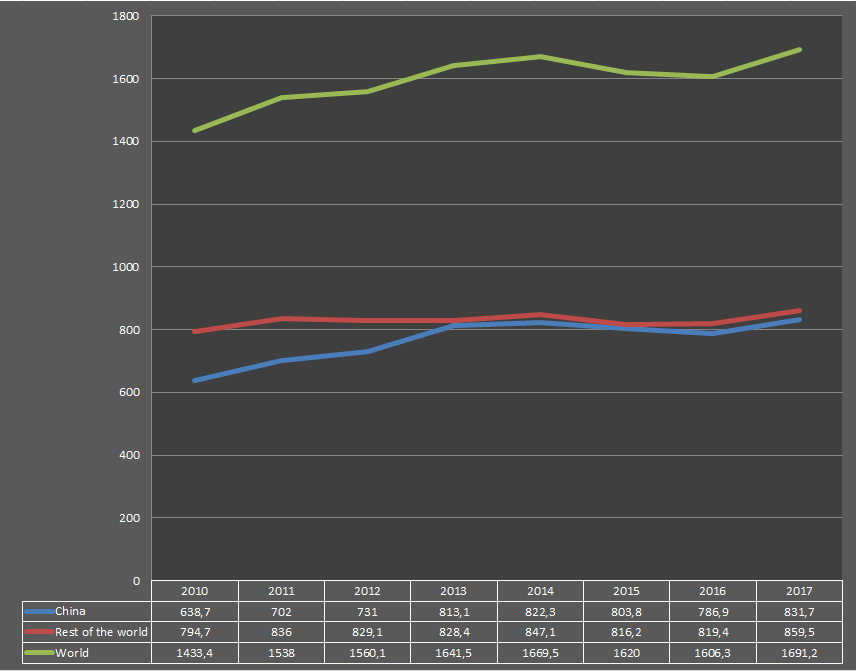
Google Scholar
The table below summarizes per-year mentions on Google Scholar as of May 17, 2021.
| Year | steel | steel research | steel properties | steel applications | steel technology |
|---|---|---|---|---|---|
| 1980 | 95,800 | 40,600 | 23,500 | 13,300 | 21,800 |
| 1985 | 148,000 | 59,200 | 28,500 | 15,600 | 25,700 |
| 1990 | 207,000 | 90,600 | 41,200 | 22,800 | 39,100 |
| 1995 | 343,000 | 140,000 | 61,200 | 37,100 | 69,200 |
| 2000 | 604,000 | 231,000 | 109,000 | 72,500 | 144,000 |
| 2002 | 704,000 | 276,000 | 124,000 | 87,200 | 183,000 |
| 2004 | 847,000 | 332,000 | 156,000 | 108,000 | 204,000 |
| 2006 | 973,000 | 429,000 | 194,000 | 137,000 | 303,000 |
| 2008 | 993,000 | 521,000 | 244,000 | 163,000 | 370,000 |
| 2010 | 1,060,000 | 640,000 | 301,000 | 192,000 | 504,000 |
| 2012 | 1,060,000 | 761,000 | 414,000 | 261,000 | 602,000 |
| 2014 | 883,000 | 680,000 | 356,000 | 253,000 | 486,000 |
| 2016 | 739,000 | 516,000 | 306,000 | 229,000 | 428,000 |
| 2017 | 586,000 | 444,000 | 302,000 | 216,000 | 339,000 |
| 2018 | 414,000 | 370,000 | 218,000 | 183,000 | 272,000 |
| 2019 | 324,000 | 235,000 | 165,000 | 129,000 | 212,000 |
| 2020 | 162,000 | 149,00 | 106,000 | 85,900 | 117,000 |
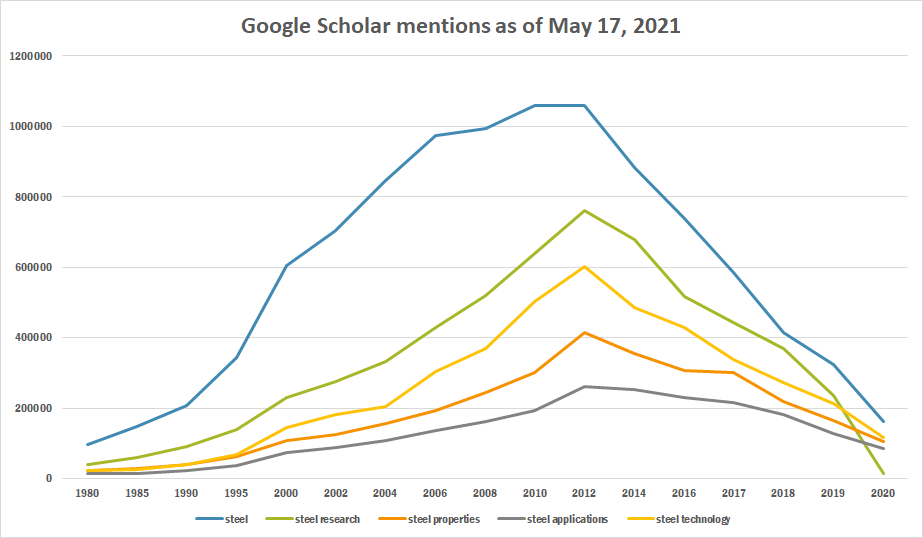
Google Trends
The comparative chart below shows Google Trends data for Steel (Topic) and Stainless steel (Topic), from January 2004 to April 2021, when the screenshot was taken. Interest is also ranked by country and displayed on world map.[86]
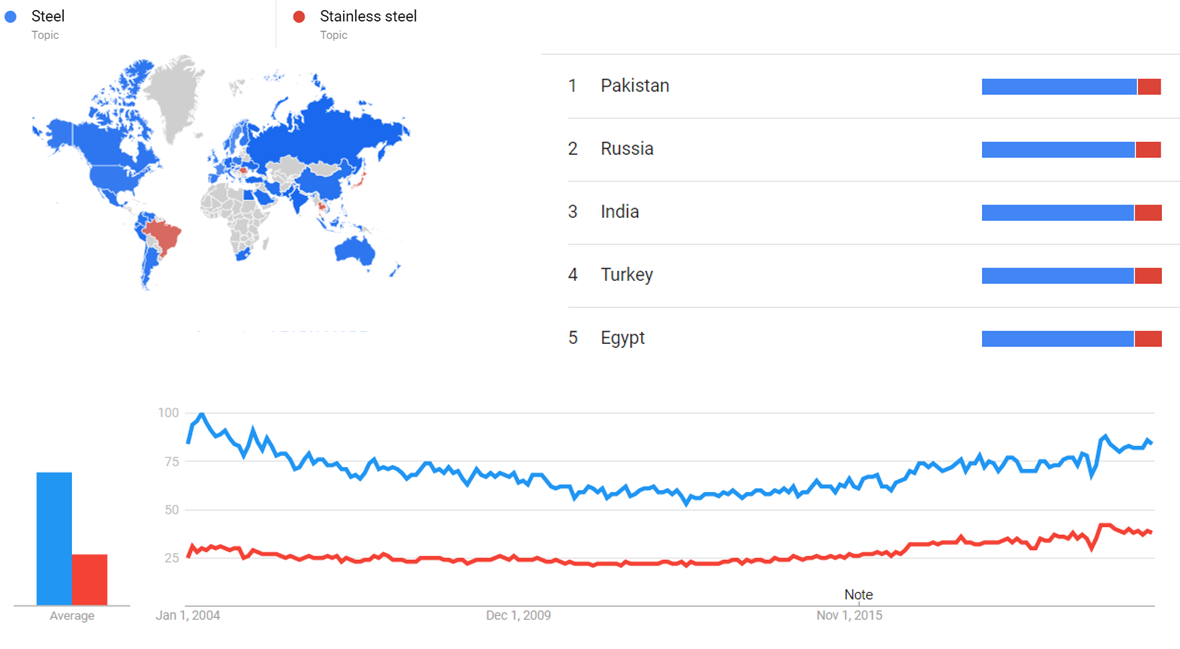
Google Ngram Viewer
The comparative chart below shows Google Ngram Viewer data for Steel and Stainless steel, from 1990 to 2019.[87]
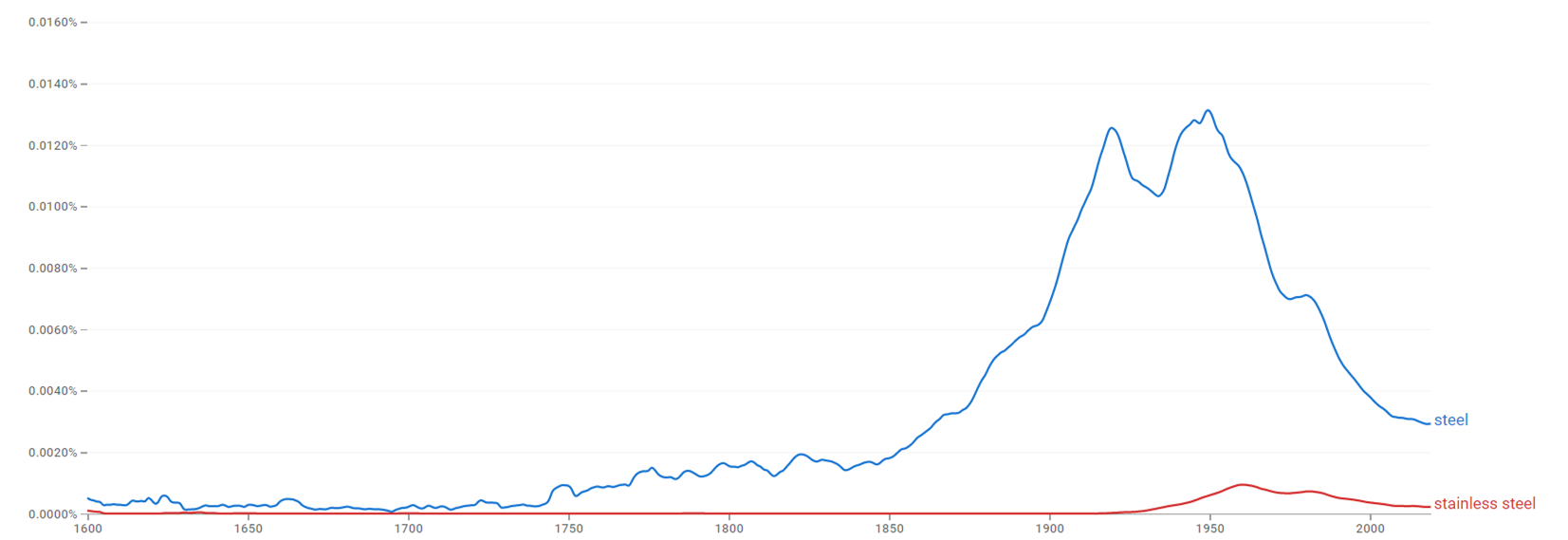
Wikipedia Views
The comparative chart below shows pageviews on desktop of the English Wikipedia articles Steel and Stainless steel from December 2007 to March 2021[88]
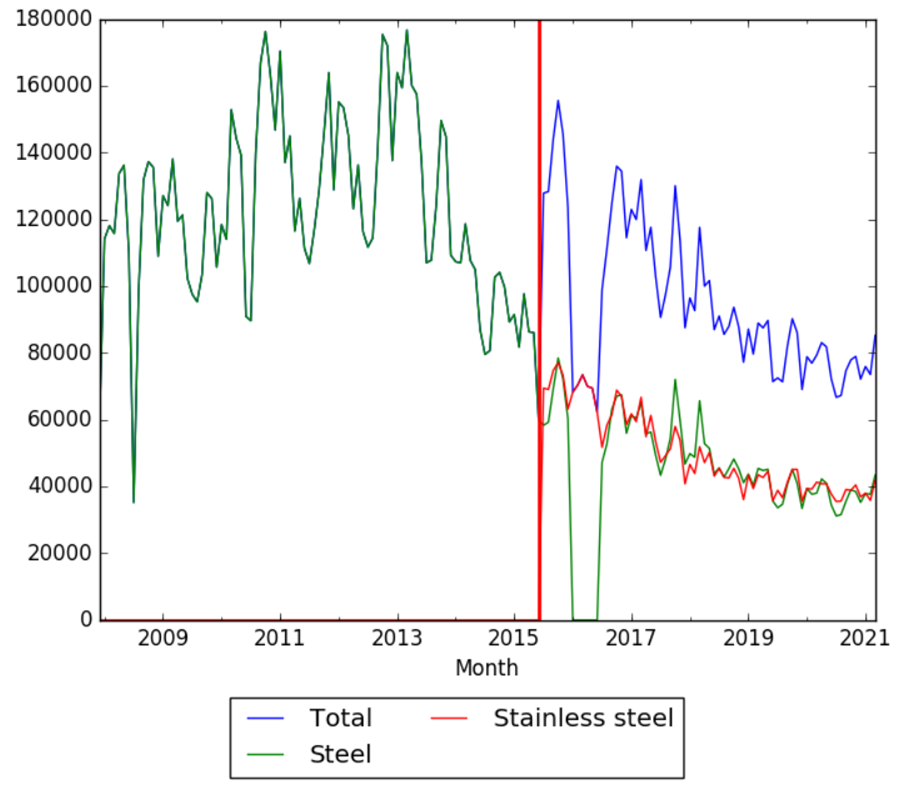
Meta information on the timeline
How the timeline was built
The initial version of the timeline was written by User:Sebastian.
Funding information for this timeline is available.
Feedback and comments
Feedback for the timeline can be provided at the following places:
- FIXME
What the timeline is still missing
- For tables: [file:///C:/Users/pc/Downloads/World%20Steel%20in%20Figures%202020i.pdf]
Timeline update strategy
Pingbacks
- Encyclopedia of Renewable and Sustainable Materials by Saleem Hashmi and Imtiaz A. Choudhury, 2020 - page 323
See also
External links
References
- ↑ 1.0 1.1 1.2 1.3 "A BRIEF HISTORY OF STEEL". dienamics.com.au. Retrieved 4 June 2018.
- ↑ 2.00 2.01 2.02 2.03 2.04 2.05 2.06 2.07 2.08 2.09 2.10 2.11 2.12 2.13 2.14 2.15 2.16 "Learn About Steel". thebalance.com. Retrieved 2 June 2018.
- ↑ 3.00 3.01 3.02 3.03 3.04 3.05 3.06 3.07 3.08 3.09 3.10 "Steel". britannica.com. Retrieved 2 June 2018.
- ↑ 4.0 4.1 4.2 "History Of The Steel Industry". economywatch.com. Retrieved 8 June 2018.
- ↑ "Iron and Steel". open.edu. Retrieved 8 June 2018.
- ↑ 6.0 6.1 6.2 6.3 "100 years of stainless steel: Developed in Krupp's research labs in Essen and first patented in 1912". thyssenkrupp.com. Retrieved 8 June 2018.
- ↑ 7.00 7.01 7.02 7.03 7.04 7.05 7.06 7.07 7.08 7.09 7.10 7.11 7.12 7.13 7.14 7.15 7.16 7.17 7.18 7.19 "History_of_Stainless_Steel" (PDF). worldstainless.org. Retrieved 8 June 2018.
- ↑ Riederer, Josef; Wartke, Ralf-B.: "Iron", Cancik, Hubert; Schneider, Helmuth (eds.): Brill's New Pauly, Brill 2009
- ↑ "How Tamils created the strongest steel in the ancient world". allmyearthlythoughts.wordpress.com. Retrieved 30 June 2018.
- ↑ "Who Invented Steel? A Look at the Timeline of Steel Production". steelfabservices.com.au. Retrieved 30 June 2018.
- ↑ "Carbon Steel and Zinc in India". brownpundits.com. Retrieved 30 June 2018.
- ↑ 12.00 12.01 12.02 12.03 12.04 12.05 12.06 12.07 12.08 12.09 12.10 12.11 "Who Invented Steel? A Look at the Timeline of Steel Production". steelfabservices.com.au. Retrieved 4 June 2018.
- ↑ 13.0 13.1 13.2 13.3 Donald, Josh. Sharp: The Definitive Guide to Knives, Knife Care, and Cutting Techniques, with Recipes from Great Chefs.
- ↑ THE MECHANICS'S MAGAZINE.
- ↑ DK. 1000 Inventions and Discoveries.
- ↑ "Krupp Steelworks". sciencephoto.com. Retrieved 29 June 2018.
- ↑ "Krupp A.G." schenkerdocumentsonline.org. Retrieved 29 June 2018.
- ↑ Zabecki, David T. Germany at War: 400 Years of Military History [4 volumes]: 400 Years of Military History.
- ↑ Hinshaw, John; Stearns, Peter N. Industrialization in the Modern World: From the Industrial Revolution to the Internet [2 volumes]: From the Industrial Revolution to the Internet.
- ↑ Chaloner, William Henry. Industry and Innovation: Selected Essays.
- ↑ "A Brief History of Steel". tf.uni-kiel.de. Retrieved 8 June 2018.
- ↑ 22.0 22.1 22.2 22.3 22.4 22.5 22.6 22.7 "The Discovery of Stainless Steel". bssa.org.uk. Retrieved 8 June 2018.
- ↑ Cobb, Harold M. The History of Stainless Steel.
- ↑ Britannica Concise Encyclopedia. Encyclopaedia Britannica, Inc.
- ↑ Fishlock, Trevor. Conquerors of Time: Exploration and Invention in the Age of Daring.
- ↑ Sugar, Bert Randolph; Richardson, C. N. The Ultimate Book of New York Lists: Everything You Need to Know about the Greatest City on Earth.
- ↑ New Scientist Dec 22-29, 1983.
- ↑ "Produced locally, delivered globally: Special steel from thyssenkrupp Steel is a giant leap for innovation in many sectors". thyssenkrupp-steel.com. Retrieved 29 June 2018.
- ↑ Buck, Jonathan. "A Steely Resolve to Rebound". barrons.com. Retrieved 29 June 2018.
- ↑ "Our History". thyssenkruppelevator.com. Retrieved 29 June 2018.
- ↑ Picken, Stuart D.B. The A to Z of Japanese Business.
- ↑ "Gerdau celebrates 110 years and announces new name for Gerdau Ameristeel and Gerdau Macsteel". gerdau.com. Retrieved 29 June 2018.
- ↑ Ramamurti, Ravi; Singh, Jitendra V. Emerging Multinationals in Emerging Markets.
- ↑ United States Steel Corporation: Hearings Before the Committee on Investigation of United States Steel Corporation. House of Representatives. [In Eight Volumes], Issues 54-63. U.S. Government Printing Office, 1912.
- ↑ "United States Steel Corporation History". fundinguniverse.com. Retrieved 29 June 2018.
- ↑ "United States Steel Corporation". referenceforbusiness.com. Retrieved 29 June 2018.
- ↑ Tata Steel diamond jubilee 1907-1967. Tata Press.
- ↑ "Heritage". tatasteeleurope.com. Retrieved 28 June 2018.
- ↑ "Tata Steel Ltd". ndtv.com. Retrieved 28 June 2018.
- ↑ 40.0 40.1 40.2 40.3 40.4 40.5 Cobb, Harold M. The History of Stainless Steel.
- ↑ "ferro chrome". metalandalloyscorporation.com. Retrieved 5 June 2018.
- ↑ Jewkes, John. The Sources of Invention.
- ↑ Reardon, Arthur C. Metallurgy for the Non-Metallurgist, Second Edition.
- ↑ "Company Overview of Shougang Group Co., Ltd". bloomberg.com. Retrieved 28 June 2018.
- ↑ "SHOUGANG GROUP". coalsteel.com. Retrieved 28 June 2018.
- ↑ "Lipetsk". russia-ic.com. Retrieved 28 June 2018.
- ↑ "Company Overview of Novolipetsk Steel". bloomberg.com. Retrieved 28 June 2018.
- ↑ "NLMK". craft.co. Retrieved 28 June 2018.
- ↑ "Nucor: Good Growth and Income Play for Steel". seekingalpha.co. Retrieved 28 June 2018.
- ↑ "Nucor Corporation". bnamericas.com. Retrieved 28 June 2018.
- ↑ Hitchner, James R. Financial Valuation: Applications and Models.
- ↑ "Company Overview of Anshan Iron and Steel Group Co., Ltd". bloomberg.com. Retrieved 28 June 2018.
- ↑ "Anshan Iron and Steel Group Corporation". privco.com. Retrieved 28 June 2018.
- ↑ 54.0 54.1 "Nipon Steel". japan-zone.com. Retrieved 28 June 2018.
- ↑ DeFusco, Richard A.; McLeavey, Dennis W.; Pinto, Jerald E.; Runkle, David E.; Anson, Mark J. P. Quantitative Investment Analysis.
- ↑ CFA Program Curriculum 2018 Level I. CFA Institute.
- ↑ "Hyundai Steel". hyundai-steel.com. Retrieved 28 June 2018.
- ↑ "Hyundai Steel Co (004020:Korea SE)". investing.businessweek.wallst.com. Retrieved 28 June 2018.
- ↑ The Directory of Gold & Silversmiths, Jewellers & Allied Traders 1838-1914. London Assay Office Registers.
- ↑ Jeannet, Jean-Pierre; Gale, Christopher. Cases in international marketing.
- ↑ "World Steel A". 50years-worldsteel.org. Retrieved 28 June 2018.
- ↑ Beijing Review, Volume 54.
- ↑ "Blog: worldsteel celebrates its 50th anniversary". worldsteel.org. Retrieved 28 June 2018.
- ↑ New Scientist 26 Jun 1980.
- ↑ "British Steel: The Problems of Rebuilding an Old Industrial Structure". jstor.org. Retrieved 29 June 2018.
- ↑ "British Steel Corporation". gracesguide.co.uk. Retrieved 29 June 2018.
- ↑ Davis, Joseph R. Stainless Steels.
- ↑ 68.0 68.1 "Biggest Steel Producing Companies In The World". worldatlas.com. Retrieved 28 June 2018.
- ↑ "History of Shagang Group". steelonthenet.com. Retrieved 28 June 2018.
- ↑ "Shen Wenrong, Chairman of the board and president of Jiangsu Shagang Group". chinadaily.com.cn. Retrieved 28 June 2018.
- ↑ "Jiangsu Shagang Group". craft.co. Retrieved 28 June 2018.
- ↑ "MOL Signs a Contract for Long-term Transport of Iron Ore with Jiangsu Shagang Group in China". mol.co.jp. Retrieved 28 June 2018.
- ↑ Smil, Vaclav (2006). Transforming the Twentieth Century: Technical Innovations and Their Consequences. Oxford, New York: Oxford University Press.
- ↑ "History". thyssenkrupp.com. Retrieved 29 June 2018.
- ↑ "ThyssenKrupp". siemens.com. Retrieved 29 June 2018.
- ↑ "Nerves of steel". economist.com. Retrieved 29 June 2018.
- ↑ "ArcelorMittal". corporate.arcelormittal.com. Retrieved 28 June 2018.
- ↑ "Hesteel Group Ltd". metalbulletin.com. Retrieved 28 June 2018.
- ↑ "HeSteel Group — Company card". cbonds.com. Retrieved 28 June 2018.
- ↑ "Company Overview of Shandong Iron and Steel Company Ltd". bloomberg.com. Retrieved 28 June 2018.
- ↑ Brødsgaard, Kjeld Erik. Globalization and Public Sector Reform in China.
- ↑ Metals and Materials (Debashish Bhattacharjee ed.).
- ↑ "Company Profile". baowugroup.com. Retrieved 28 June 2018.
- ↑ "China Baowu Steel Group". fortune.com. Retrieved 28 June 2018.
- ↑ "Chinese steel giant established after key merger". chinadailyasia.com. Retrieved 28 June 2018.
- ↑ "Steel and Stainless steel". Google Trends. Retrieved 17 April 2021.
- ↑ "Steel and Stainless steel". books.google.com. Retrieved 17 April 2021.
- ↑ "Steel and Stainless steel". wikipediaviews.org. Retrieved 1 May 2021.